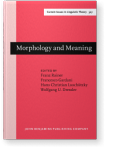Tuning morphosemantic transparency
by shortening
A cross-linguistic perspective
The central claim of this paper is that, besides phonological optimization, a major function of shortening words by different techniques such as clipping or acronymy is a controlled reduction of morphosemantic transparency in lexical domains, where partly or entirely opaque words are preferred to completely transparent ones. E.g., the functions of uniquely identifying and individualizing a referent by a proper name are better fulfilled by opaque labeling than by a transparent descriptive nomination. In fact, a study of shortening techniques used for official and commercial proper names contrasted with non-onymic words from the general lexicon and certain jargons in German, Farsi and Standard Chinese, three languages extremely different with respect to linguistic type and writing system, reveals a clear contrast between highly transparent shortenings preferred in the non-onymic lexicon versus less transparent or even opaque ones in the proper names, although the preferred shortening techniques themselves vary from language to language.
References (29)
References
Bellmann, Günther. 1980. “Zur Variation im Lexikon: Kurzwort und Original”. Wirkendes Wort 30.369–383.
Balnat, Vincent. 2011. Kurzwortbildung im Gegenwartsdeutschen. Hildesheim: Olms.
Cannon, Garland. 1989. “Abbreviations and Acronyms in English Word-Formation”. American Speech 64: 2.99–127. 

Kobler-Trill, Dorothea. 1994. Das Kurzwort im Deutschen: Eine Untersuchung zu Definition, Typologie und Entwicklung. Tübingen: Niemeyer. 

Lappe, Sabine. 2007. English Prosodic Morphology. Berlin: Springer. 

Marchand, Hans. 1969. The Categories and Types of Present-Day English Word Formation. 2nd ed. München: C. H. Beck.
Majidi, Mohammad-Reza. 1990. Strukturelle Grammatik des Neupersischen (Fārsi), vol. 2, Morphologie. Hamburg: Helmut Buske.
Norman, Jerry. 1988 [1936]. Chinese. Cambridge: Cambridge University Press.
Nübling, Damaris, Fabian Fahlbusch & Rita Heuser. 2012. Namen. Eine Einführung in die Onomastik. Tübingen: Gunter Narr.
Packard, Jerome L. 2000. The Morphology of Chinese. A Linguistic and Cognitive Approach. Cambridge: Cambridge University Press. 

Ronneberger-Sibold, Elke. 1992. Die Lautgestalt neuer Wurzeln. Kürzungen und Kunstwörter im Deutschen und Französischen. Postdoc dissertation. University of Freiburg i. Br.
Ronneberger-Sibold, Elke. 1995. “On Different Ways of Optimizing the Sound Shape of Words”. Historical Linguistics 1993: Selected Papers from the 11th International Conference on Historical Linguistics Los Angeles, 16–20 August 1993 ed. by Henning Andersen, 421–432. Amsterdam & Philadelphia: John Benjamins.

Ronneberger-Sibold, Elke. 2001. “On Useful Darkness: Loss and Destruction of Transparency by Linguistic Change, Borrowing, and Word Creation”. Yearbook of Morphology 1999 ed. by Geert Booij & Jaap van Marle, 97–120. Dordrecht: Springer. 

Ronneberger-Sibold, Elke. 2010. “Word Creation: Definition – Function – Typology”, Variation and Change in Morphology: Selected Papers from the 13th International Morphology Meeting, Vienna, February 2008 ed. by Franz Rainer, Wolfgang U. Dressler, Dieter Kastovsky & Hans Christian Luschützky, 201–216. Amsterdam & Philadelphia: John Benjamins. 

Seiler, Hansjakob. 1975. “Die Prinzipien der deskriptiven und der etikettierenden Benennung. ” Linguistic Workshop III ed. by Hansjakob Seiler, 2–57. München: Fink.
Steinhauer, Anja. 2000. Sprachökonomie durch Kurzwörter. Bildung und Verwendung in der Fachkommunikation. Tübingen: Gunter Narr.
Ungerer, Friedrich. 1991. “Acronyms, Trade Names, and Motivation”. Arbeiten aus Anglistik und Amerikanistik 16.131–158.
Sources of the corpus. Catalogues Groups Iran’s Industries, Exports, and Minerals [sic]. 1354–1955 /1975–1976. Tehrān: Rahnema Organization.
Duden. Rechtschreibung der deutschen Sprache und der Fremdwörter. 1986 19th ed. Mannheim: Dudenverlag.
Ekrāmi, Mahmud. 1385/2006. Mardomshenāsi. Estelāhāt-e khodemāni [Ethnology. Colloquial Idiomatics]. 3rd ed. Mashhad: Nashr-e ivār.
Farhangestān-e zabān va adabiyāt-e Fārsi. Goruh-e takhasosi-ye ekhtesārāt [Academy for Persian Language and Literature. Special Group for Abbreviations], ed. 1378/1999. Osul va zavābet va raveshhā-ye ekhtesārsāzi [Principles, Conditions, and Methods of Abbreviation]. Tehrān: Farhangestān-e zabān va adabiyāt-e Fārsi.
Ling, Yuanzheng. 2002. Xiandai hanyu suolüeyu [Abbreviations in Modern Chinese]. Beijing: Yuwen chubanshe [Publishing House for Language and Script].
Liu, Yaping. 2007. Wangluo wenxue yuan de 'kuanghuanhua' tese [On the Peculiarities of the “ Tendency Towards Wit and Craziness” in the Language of Internet Literature]. Changchun gongye daxue xuebao. Shehui kexueban [Journal of Changchun University of Technology Social Sciences Edition] 19, Nr. 01, March 2007, 105–106.
Lötscher, Andreas. 1992. Von Ajax bis Xerox. Ein Lexikon der Produktenamen. 2nd ed. Zürich: Artemis und Winkler.
Parchami, Mohebollāh. 2004. Paskucheh?-ye Farhang [Dark Alleys of Culture]. Tehrān: Farhang-e Mahrokh.
Sam?‘i, Mahdi. 1383/2004. Farhang-o-loqāte zabāne makhfi [Glossary of the Secret Language]. 3rd ed. Tehrān: Nashr-e markaz.
Shanghai Daily, ed. 2007. Chinese Buzzwords with English Explanations. Shanghai: Better Link.
Wildhagen, Karl. 1972. Englisch-deutsches und deutsch-englisches Wörterbuch in zwei Bänden. Vol. 2: Deutsch Englisch. 2nd ed. by Will Héraucourt. Wiesbaden. (Appendix of current German abbreviations)
Xiandai hanyu cidian [Dictionary of modern Chinese]. 2009. Zhongguo shehui kexueyuan yuyan yanjiusuo cidianbianji shi [Chinese Academy of Social Sciences. Institute for Linguistic Research. Dictionary Section]. 5th ed. Beijing: Shangwu yinshuguan [Commercial Press].
Cited by (2)
Cited by two other publications
Akbari, Fatemeh
2020.
Assessment of Iran’s Language Planning: Methodology. In
Iran’s Language Planning Confronting English Abbreviations [
SpringerBriefs in Linguistics, ],
► pp. 53 ff.

Akbari, Fatemeh
2020.
Assessment of Iran’s Language Planning: Discussions. In
Iran’s Language Planning Confronting English Abbreviations [
SpringerBriefs in Linguistics, ],
► pp. 79 ff.

This list is based on CrossRef data as of 24 july 2024. Please note that it may not be complete. Sources presented here have been supplied by the respective publishers.
Any errors therein should be reported to them.
